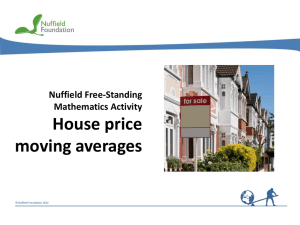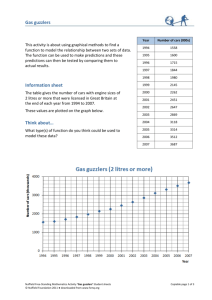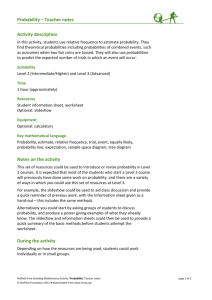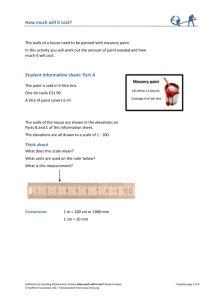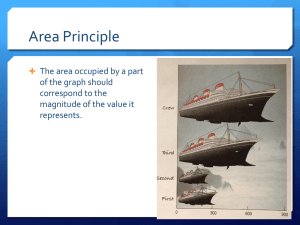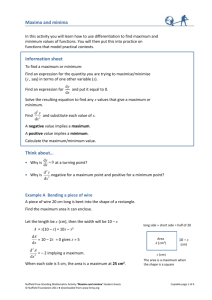Student sheets Word - Nuffield Foundation
advertisement
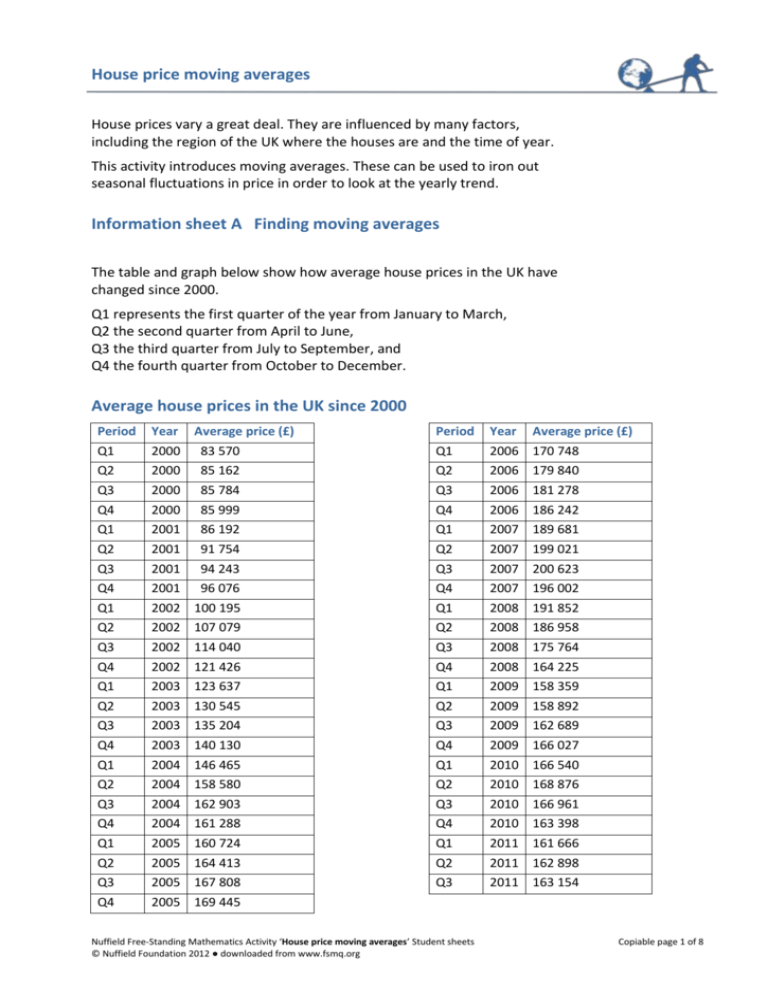
House price moving averages House prices vary a great deal. They are influenced by many factors, including the region of the UK where the houses are and the time of year. This activity introduces moving averages. These can be used to iron out seasonal fluctuations in price in order to look at the yearly trend. Information sheet A Finding moving averages The table and graph below show how average house prices in the UK have changed since 2000. Q1 represents the first quarter of the year from January to March, Q2 the second quarter from April to June, Q3 the third quarter from July to September, and Q4 the fourth quarter from October to December. Average house prices in the UK since 2000 Period Q1 Q2 Year Average price (£) 2000 83 570 2000 85 162 Period Q1 Q2 Year Average price (£) 2006 170 748 2006 179 840 Q3 Q4 2000 2000 85 784 85 999 Q3 Q4 2006 181 278 2006 186 242 Q1 Q2 2001 2001 86 192 91 754 Q1 Q2 2007 189 681 2007 199 021 Q3 Q4 2001 2001 94 243 96 076 Q3 Q4 2007 200 623 2007 196 002 Q1 2002 100 195 Q1 2008 191 852 Q2 2002 107 079 Q2 2008 186 958 Q3 2002 114 040 Q3 2008 175 764 Q4 2002 121 426 Q4 2008 164 225 Q1 2003 123 637 Q1 2009 158 359 Q2 Q3 2003 130 545 2003 135 204 Q2 Q3 2009 158 892 2009 162 689 Q4 Q1 2003 140 130 2004 146 465 Q4 Q1 2009 166 027 2010 166 540 Q2 Q3 2004 158 580 2004 162 903 Q2 Q3 2010 168 876 2010 166 961 Q4 2004 161 288 Q4 2010 163 398 Q1 2005 160 724 Q1 2011 161 666 Q2 2005 164 413 Q2 2011 162 898 Q3 2005 167 808 Q3 2011 163 154 Q4 2005 169 445 Nuffield Free-Standing Mathematics Activity ‘House price moving averages’ Student sheets © Nuffield Foundation 2012 ● downloaded from www.fsmq.org Copiable page 1 of 8 Think about … How have house prices in the UK changed since 2000? Do the house prices change more in some quarters of the year than in others? What evidence does the table or graph give of this? How could fluctuations due to seasonal factors be smoothed out? Seasonally adjusted average house prices Moving averages can be used to smooth out fluctuations due to seasonal factors. In this case combining the values for 4 quarters gives the moving averages shown below: x 2000Q4 85 999 85 784 85 162 83 570 = £85 129 (nearest £) 4 where the symbol x2000Q4 means ‘the mean of the 4 quarters up to and including the 4th quarter of 2000’. The calculation shows the most recent price first. x 2001Q1 86 192 85 999 85 784 85 162 = £85 784 (nearest £) 4 x 2001Q2 91 754 86 192 85 999 85 784 = £87 432 (nearest £) 4 x 2001Q3 94 243 91 754 86 192 85 999 = £89 547 4 96 076 94 243 91 754 86 192 = £92 066 (nearest £) 4 These have been entered into the table below. x 2001Q4 Nuffield Free-Standing Mathematics Activity ‘House price moving averages’ Student sheets © Nuffield Foundation 2012 ● downloaded from www.fsmq.org Copiable page 2 of 8 Period Year Q1 2000 Average price (£) 83 570 Q2 2000 Q3 Q4 Moving average (£) Period Year Q1 2006 Average price (£) 170 748 85 162 Q2 2006 179 840 2000 2000 85 784 85 999 85 129 Q3 Q4 2006 2006 181 278 186 242 Q1 2001 86 192 85 784 Q1 2007 189 681 Q2 2001 91 754 87 432 Q2 2007 199 021 Q3 2001 94 243 89 547 Q3 2007 200 623 Q4 2001 96 076 92 066 Q4 2007 196 002 Q1 2002 100 195 Q1 2008 191 852 Q2 Q3 2002 2002 107 079 114 040 Q2 Q3 2008 2008 186 958 175 764 Q4 Q1 2002 2003 121 426 123 637 Q4 Q1 2008 2009 164 225 158 359 Q2 Q3 2003 2003 130 545 135 204 Q2 Q3 2009 2009 158 892 162 689 Q4 Q1 2003 2004 140 130 146 465 Q4 Q1 2009 2010 166 027 166 540 Q2 Q3 Q4 2004 2004 2004 158 580 162 903 161 288 Q2 Q3 Q4 2010 2010 2010 168 876 166 961 163 398 Q1 Q2 2005 2005 160 724 164 413 Q1 Q2 2011 2011 161 666 162 898 Q3 Q4 2005 2005 167 808 169 445 Q3 2011 163 154 Moving average (£) Try this A Calculate the moving averages for 2002, 2003 and 2004. Enter the values you find into the table above. Nuffield Free-Standing Mathematics Activity ‘House price moving averages’ Student sheets © Nuffield Foundation 2012 ● downloaded from www.fsmq.org Copiable page 3 of 8 Information sheet B Alternative method for finding moving averages A moving average can also be found from the previous value as shown for x2001Q4 below. x 2001Q4 x 2001Q3 85 999 96 076 4 4 = 89 547 – 21 499.75 + 24 019 = 92 066 (nearest £) So x 2002Q1 x 2001Q4 86 192 100 195 4 4 = 92 066 – 21 548 + 25 048.75 = 95 567 (nearest £) Check that this value agrees with the value you have entered into the table above. Try this B Use the alternative method to calculate the moving averages for 2005, 2006 and 2007. Enter the values you find into the table above. Complete the table using either of the methods for finding moving averages. Think about… Both methods for finding moving averages are given in general terms below. Which method do you prefer? Why? Moving averages For data points p1, p2, … the simple moving average at interval m with n data points is: xm p m p m1 p m2 ..... p m( n1) n Alternatively, calculate successive values using xm 1 xm p m( n1) n p m1 n Nuffield Free-Standing Mathematics Activity ‘House price moving averages’ Student sheets © Nuffield Foundation 2012 ● downloaded from www.fsmq.org Copiable page 4 of 8 Information sheet C Graph showing moving averages The 2000 and 2001 moving averages have been plotted on the ‘House price’ graph below. Try this C Plot the other moving averages from the table onto the graph and join them with a smooth curve. Think about… What effect has using moving averages had on the trend line? Can you think of a way to adjust the lag which has occurred? Nuffield Free-Standing Mathematics Activity ‘House price moving averages’ Student sheets © Nuffield Foundation 2012 ● downloaded from www.fsmq.org Copiable page 5 of 8 Information sheet D Weighted moving averages The problem of lag can be alleviated by using a weighted moving average. Here are calculations for the 2000 and 2001 weighted moving averages for house prices: x 2000Q4 4 85 999 3 85 784 2 85 162 83 570 855 242 = = £85 524 (nearest £) 4 3 2 1 10 x 2001Q1 4 86 192 3 85 999 2 85 784 85 162 859 495 = = £85 950 (nearest £) 4 3 2 1 10 x 2001Q2 4 91 754 3 86 192 2 85 999 85 784 883 374 = = £88 337 (nearest £) 4 3 2 1 10 x 2001Q3 4 94 243 3 91 754 2 86 192 85 999 910 617 = = £91 062 (nearest £) 4 3 2 1 10 x 2001Q4 4 96 076 3 94 243 2 91 754 86 192 936 733 = = £93 673 (nearest £) 4 3 2 1 10 The method for finding the linear weighted moving average is given in general terms in the box below. Note the formula When n = 4, nn 1 2 = nn 1 2 44 1 2 given for finding the sum of values in the denominator. = 10 as used above. In this example this is no quicker than adding 4, 3, 2 and 1. However, in cases where n is large, nn 1 the formula is much quicker than adding the individual values. 2 Weighted moving averages The linear weighted moving average is x m np m n 1 p m1 n 2 p m2 ..... p m( n1) n n 1 n 2 ... 2 1 where the denominator is the triangular number with sum nn 1 Nuffield Free-Standing Mathematics Activity ‘House price moving averages’ Student sheets © Nuffield Foundation 2012 ● downloaded from www.fsmq.org 2 . Copiable page 6 of 8 The values calculated above have been entered into the table below. Period Q1 Year 2000 Average price (£) 83 570 Q2 2000 Q3 Q4 Weighted moving average (£) Period Q1 Year 2006 Average price (£) 170 748 85 162 Q2 2006 179 840 2000 2000 85 784 85 999 85 524 Q3 Q4 2006 2006 181 278 186 242 Q1 2001 86 192 85 950 Q1 2007 189 681 Q2 2001 91 754 88 337 Q2 2007 199 021 Q3 2001 94 243 91 062 Q3 2007 200 623 Q4 2001 96 076 93 673 Q4 2007 196 002 Q1 2002 100 195 Q1 2008 191 852 Q2 2002 107 079 Q2 2008 186 958 Q3 2002 114 040 Q3 2008 175 764 Q4 Q1 2002 2003 121 426 123 637 Q4 Q1 2008 2009 164 225 158 359 Q2 Q3 2003 2003 130 545 135 204 Q2 Q3 2009 2009 158 892 162 689 Q4 Q1 2003 2004 140 130 146 465 Q4 Q1 2009 2010 166 027 166 540 Q2 2004 158 580 Q2 2010 168 876 Q3 2004 162 903 Q3 2010 166 961 Q4 Q1 Q2 2004 2005 2005 161 288 160 724 164 413 Q4 Q1 Q2 2010 2011 2011 163 398 161 666 162 898 Q3 2005 167 808 Q3 2011 163 154 Q4 2005 169 445 Weighted moving average (£) Try this D Complete the rest of the table. The graph on the following page shows the weighted moving averages for 2000 and 2001. Plot the other weighted moving averages from the table onto the graph, and join them with a smooth curve. You should find that the lag is less severe than on the previous graph. Nuffield Free-Standing Mathematics Activity ‘House price moving averages’ Student sheets © Nuffield Foundation 2012 ● downloaded from www.fsmq.org Copiable page 7 of 8 Reflect on your work • What is a moving average? Why are they used? • Describe two methods of calculating a moving average. • Describe how to find a weighted moving average. • Why does a weighted moving average help to overcome the problem of lag? Notes on the data The data are adapted from The Halifax House Price Index spreadsheet at http://www.lloydsbankinggroup.com/media1/research/halifax_hpi.asp This website gives data for years before 2000 which could be used for finding moving averages over longer periods. Please note that any use of the data for an individual's own or third party commercial purposes is done entirely at the risk of the person or persons making such reliance. Nuffield Free-Standing Mathematics Activity ‘House price moving averages’ Student sheets © Nuffield Foundation 2012 ● downloaded from www.fsmq.org Copiable page 8 of 8
